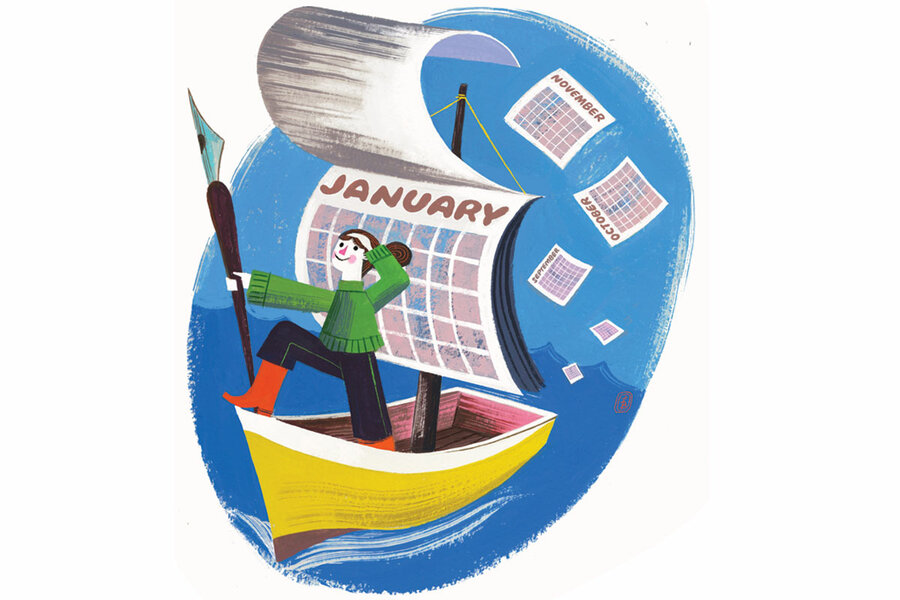‘A visual map of my life.’ Navigating a new year, calendar in hand.
Loading...
When my co-workers switched to digital calendars a few years ago, I went along, too. You can’t beat the efficiency of software that logs each appointment and sends little pop-up reminders of when and where you’re supposed to be, a not-so-gentle tug on the sleeve that I’ve come to rely upon.
Even so, to prepare for the new year, I recently trekked to the local stationery shop for a paper calendar for 2024, still drawn to the pleasures of this decidedly retro commodity. I love an old-fashioned calendar’s sense of time as a story, the coming 12 months arranged as neatly as books on a shelf. I flip through the pages of each new calendar in a quick check of their chronology, pleasantly assured that July is once again slated to follow June.
I also enjoy the sheer blankness of each unblemished page, January as open and white as a winter landscape. Soon enough, the squares will cloud as I scribble in deadlines and dental appointments, business meetings and oil changes, social functions and family gatherings. It’s odd how quickly a year begins to hum, the calendar’s grids darkening, like a hive of bees, with the urgency of things to do.
In the tug and pull of a closely scheduled life, the remaining vacant spaces of a calendar begin to stand out even more. I exhale a bit each time I see Sunday on my paper calendar, its little block as hollow as a glass jar, just waiting to be filled with whatever I please. I’m also heartened each summer by a string of August dates, empty as a castaway beach, their blocks marked by a single word: “Vacation.”
Beyond those respites, as I burrow through the obligations that fill a year, my paper calendar makes the days seem real. Time, already a mystery, can feel even more abstract when doled out by the teaspoon on a smartphone app. But when I open my traditional calendar and lay it flat on my desk, time becomes tangible. What I’m seeing, in the march of months stretching toward the future, is a map of my life.
Opinions vary on the best paper calendar to get. Some folks like the novelty kind, with each month devoted to a colorful cat, a tropical bird, a shaggy dog, a majestic nature scene, or a vintage cartoon. These sorts of calendars were a forerunner, I suppose, of the screensavers on computers – a way to give ordinary days a sense of occasion. Those themed calendars can be a lot of fun, although maybe, like online life, they can try a bit too hard to curate each moment as a spectacle or a punchline.
I prefer plain calendars, in which the months themselves are the stars. The months we use to keep time should be arresting enough, growing as they do from classic mythology. Here’s to January, named after Janus, the Roman god of beginnings and endings, and February, a nod to februum, with its ancient rites of purification. Breeze through the other months, whether May with its distant festivals of fertility or July and its homage to Julius Caesar, and even a basic calendar can frame time as a cosmic pageant, one that doesn’t need a canned photo of a folded sunset to gild its significance.
The calendar I prefer is styled like a decent spiral notebook, with a simple black cover as plain as a Pilgrim’s shoe. Pocket-size calendars strike me as too small, compressing the year into a hard lump of coal. Those huge desk calendars that sprawl across like bathmats are, on the other hand, somewhat too massive for me. I don’t want a tableau as big as a board game to navigate a week.
Looking at life in the rearview mirror of a depleted calendar can be wistful. I see parties attended, christenings celebrated, birthdays marked, and projects either satisfyingly completed or regretfully abandoned. I sometimes notice canceled lunch dates with good friends that were never rescheduled, which makes me resolve to embrace and prioritize meaningful connections.
Fortunately, each new paper calendar brings a chance to start over. I open to January, pen in hand, and begin to write the next chapter of my life.





